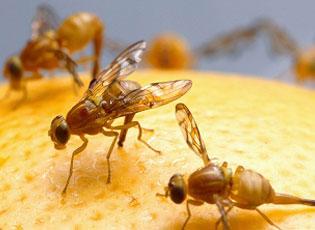Anastrepha ludens (Loew, 1873) (ITIS)
Mexican fruit fly, Mexfly
Anastrepha lathana, Trypeta ludens (ITIS)
Mexico and Central America (Flitters and Messenger 1965)
First observed as a winter migrant in southern Texas in 1903, with infestations occurring beginning in 1927; it was first discovered outside of its usual range in 1954 (Flitters and Messenger 1965)
Migrates into southern Texas from Mexico; may be introduced to other areas through the movement of infested fruit (Aluja 1994; Thomas 2004)
Larvae attack at least 60 varieties of fruit, particularly citrus and mangoes (Thomas 2004)

Mexican Fruit Fly
In grapefruit as well as many other fruits, one female Mexican fruit fly can deposit large numbers of eggs: up to 40 eggs at a time, 100 or more a day, and about 2,000 over her life span - Jack Dykinga, USDA. Agricultural Research Serv
Spotlights
Distribution / Maps / Survey Status
Federally Regulated
All Resources
Selected Resources
The section below contains highly relevant resources for this species, organized by source.
Partnership
Federal Government
State and Local Government
Academic
Aluja, M. 1994. Bionomics and management of Anastrepha. Annual Review of Entomology 39:155-178.
Flitters, N.E., and P.S. Messenger. 1965. Effect of temperature and humidity on development and potential distribution of the Mexican fruit fly in the United States (Technical Bulletin 1330). Washington, D.C.: U.S. Department of Agriculture.
Integrated Taxonomic Information System. Anastrepha ludens. [Accessed Sep 19, 2023].
Thomas, D.B. 2004. Hot peppers as a host for the Mexican fruit fly Anastrepha ludens (Diptera: Tephritidae). Florida Entomologist 87(4):603-608.
